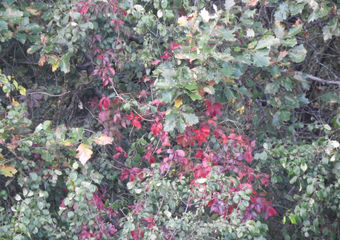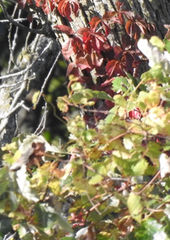Virginia Creeper
Common Name: Virginia Creeper.
Scientific Name: Parthenocissus Quinquefolia.
What to look for? Woody vine crawling up trees and shrubs in the woodlands – autumn red in the fall! The Virginia Creeper tends to be a high-climbing vine. It has aerial roots, hairy leaf stalks and new stems, and tendrils with short branches that eventually develop flat adhesive disks or pads at the tip to take hold on the tree trunks. The palmate compound leaves - consisting of five (5) leaflets - are quite distinctive. Their stems are initially green and hairless, but eventually they become brown and woody. Occasionally, panicles of yellowish green flowers are produced, consisting of five (5) green petals, five (5) stamens, and a pistil with a stout style. The stamens have white filaments with large yellow anthers. Each flower is replaced by a fleshy berry that contains several seeds. Each berry is initially green, but it becomes blue-violet during the autumn. During the fall, the foliage becomes colorful, varying from burgundy to brilliant scarlet.
Where can they be found at Carillon Stonegate Pond? The Virginia Creeper may be found climbing some of the large trees in the forest preserve across our ponds. The red color of the leaves are especially noticeable in the fall.
How big are they? The Virginia Creeper vine can grow to over forty (40) feet tall. The oblong leaves are up to six (6) inches long and two and one-half (2.5) inches wide. The small flowers are less than one-half (0.5) of an inch across.
Where do they grow and thrive? The Virginia Creeper is native to the U.S. and is found throughout eastern and central North America, from southern Canada to eastern Mexico. The native Virginia Creeper occurs in every county of Illinois. Habitats include deciduous woodlands, woodland borders, thickets, gravelly seeps, limestone glades, rocky bluffs, fence rows, abandoned or little-used railroads, and walls of buildings.
When do they bloom? The Virginia Creeper blooms during late spring into late summer from May to August.
Do birds, insects or other wildlife associate with this plant? The nectar and pollen of the flowers occasionally attract various bees. Insects that feed on Virginia Creeper include larvae of a variety of beetles and moths. The berries are eaten by several species of songbirds that inhabit thickets and woodlands and by foxes and skunks. The foliage and branches are browsed by the White-Tailed Deer and Cottontail Rabbit.
Interesting Facts About the Virginia Creeper:
-
Virginia Creeper has many other common names including five-leaved ivy (it is not closely related to the true ivy), five-finger, and woodbine.
-
Virginia Creeper is a native climber in the grape family.
-
The plant’s tissues and sap contain microscopic, irritating needle-like calcium oxalate crystals called raphides that can cause contact dermatitis (skin irritation and blisters) in sensitive people.
-
Virginia creeper is sometimes mistaken for poison ivy (Toxicodendron radicans) because of its similar growth habit and size of the leaves, but is easy to distinguish by the five leaflets, whereas poison ivy always has only three leaflets.
For more information on the Virginia Creeper and sources of information used in this blog (these are several of the sources that I am using to learn as I blog), please visit Illinois Wildflowers, Minnesota Wildflowers, and Missouri Department of Conservation.
The Carillon at Stonegate community is very fortunate to have a variety of wetland, forest and prairie environments conducive to a variety of birds and other wildlife, insects and plants. Our community and the Kane County Forest Preserve do an exceptional job in maintaining this natural environment – both for the benefit of the birds and wildlife and for our residents to enjoy.
Take a hike and see what you can find – and identify!













